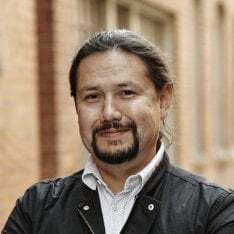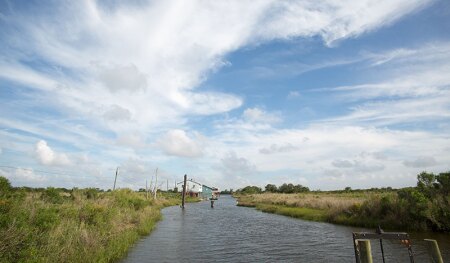This Urban Land Online series (see series introduction by SpruceLab here) introduces real estate and built environment professionals to Indigenous-led organizations working on issues of environmental and climate justice in the built environment as they pertain to Indigenous communities. In addition to profiling the work of these organizations, the series covers why these intersections are critical to understand within the wider conversation on climate change and social equity. This iteration is a follow-up to a similar series of profiles created in 2020 on environmental justice, which were collected and published as ULI’s Environmental Justice and Real Estatereport.
Location: O’ghe P’oghe or Santa Fe, New Mexico
For more information: https://massdesigngroup.org/sustainable-native-communities
Type of Organization: MASS Design Group is a mission-driven organization founded to support partners in delivering innovative capital projects that fundamentally improve lives and act as enablers of shared prosperity.
Mission: The mission of the Sustainable Native Communities Design Lab is to close the wealth gap in Indian Country through culturally responsive housing development and Native homeownership.
Interview with: Joseph Kunkel, Principal and Director
UL: What is your organization’s area of focus, and how does it relate to the built environment and land use?
Joseph Kunkel: Our work focuses on leveraging architecture, as well as inclusive design and construction processes, to create better health, justice, equity, and long-term sustainability. Within MASS, I direct the Sustainable Native Communities Design Lab based out of our Santa Fe office, located in O’ghe P’oghe, the original Tewa name for Santa Fe, which means White Shell Water Place.
The southwest is home to the largest collective Indigenous population in what is now the United States, and this is where the Department of Housing & Urban Development’s Office of Native American Programs largest allocation of NAHASDA (Native American Housing Assistance and Self Determination Act) dollars are located. The work coming out of our office, while regionally based, also influences MASS’s larger portfolio of built work and land use. Through the Sustainable Native Communities Design Lab, we seek to learn from Indian Country, lift up relationships around Native-non-Native partnership, and expand MASS’s work to address the inequality we see throughout the built environment.
How do you define environmental and climate justice in your work through an indigenous lens?
We have a unique approach to sustainability, and not just sustainability from a technical standpoint, but from a cultural perspective. We approach each of our projects by asking how we can invest design thinking into the cultural nuances of the communities we serve. How can we help to build the capacity of the organizations we work with?
The Sustainable Native Communities Design Lab emerged by trying to understand the gaps within the built environment — identifying the communities that were not being served by the profession, and were being fundamentally harmed by the built environment. Adequate housing can provide more than just environmental and health benefits—when designed well, the process of constructing housing can also be a vehicle for economic development.
We as designers, architects, planners, and engineers have an obligation to understand the impacts our buildings have on our environment, and within our communities. The more resilient we design and build our communities, the better we can serve the families and individuals who live there. The better prepared they will be when the next natural or man-made disaster strikes due to the changing climate. The more we invest now in our rural and Tribal communities, the more sustainable our buildings will be.
What do you hope to see from the real estate sector, especially given current increased awareness of racial and environmental justice? How can the real estate community support work like yours?
There are over five million tribal members in the United States, belonging to one of 573 federally recognized tribes. Centuries of land dispossession, cultural genocide, and violence toward Native populations have produced a striking wealth gap: one in three Native American people lives below the poverty line, compared to 11.8% of the American population overall. While home-ownership has provided an engine of wealth creation and upward mobility for millions of Americans, Native American communities have been largely denied this opportunity.
Indian Country is in a housing crisis, facing a deficit of 200,000 total units. This gross shortage in housing has resulted in poor living conditions and high rates of overcrowding. Under the current federal funding model, this shortage will take approximately 120 years to fill. There is an opportunity for private capital to proactively fill this funding gap; however, currently less than 0.03 percent of philanthropic dollars reach Indian Country, even though Native Americans make up 2 percent of the U.S. population. In order to advance equal opportunity, self-determination, and sovereignty, a new model of practice is needed to catalyze housing development in Indian Country.
The mission of the Sustainable Native Communities Design Lab is to close the wealth gap in Indian Country through culturally responsive housing development and Native home ownership. Housing also needs to be a catalyst for community pride and economic growth. The financing of projects and of homeownership is key, and innovative “design thinking” about financing can reap dividends. If block grants can be used not just for building a home but for down-payment assistance, then it will give more families a chance to become financially stable and qualify for mortgages to build financial independence and create wealth for generations to come.
It’s not just buildings that can be erected. If the right measures are adopted in projects, the result will be workforce development too. Skilled and unskilled Native artisans can be hired on construction teams. This can fuel both employment and business growth. That growing labor force will generate money and keep those dollars circulating within the community. MASS Design Group has experienced this in our work in Rwanda on community development projects ranging from universities to conservation and health-care campuses. This is an argument for internally focused, regenerative capitalism and real estate. It’s a sustainable model, and sustainability is a foundational value for many Indigenous peoples.
What does it mean to develop culturally responsive, climate-resilient housing and community infrastructure in Native communities? What lessons apply from this work to the broader spectrum of BIPOC communities?
Climate resilient, culturally responsive housing is housing that is responding to our times, and the issues our Tribal and Rural communities are facing right now. Hotter summers, colder winters, higher cooling costs, and higher heating costs. The design and construction of homes and community infrastructure will need to respond to this crisis. We need to build homes that are lower in carbon footprint, that use less energy while keeping families warm in the coldest months, and cool in the hottest months. We must explore low-carbon materials, which Indigenous peoples have used for millennia, prior to western contact, including adobe bricks, hempcrete, strawbale, and wood. We must use less concrete materials, which are high in embodied carbon. We have the technology, we have the knowledge, and we know how to use it, we just need to make a case for why we must pay for them.
At MASS, we approach each of our projects with a process that we call immersion. We recognize that because we aren’t present in every community in which we work, it is critical that we identify and collaborate with partners who are integrated within communities they serve. Together, we can navigate the social-political dynamics of a space and address climate challenges in a way that is culturally responsive. This has been critical in working with Native communities, and I hope that we as a country can all do a better job of listening. Not only to our Indigenous populations, but to all of our under-represented communities when we consider developing new infrastructure and architecture. This work can’t be done by any one group of people. When thinking about reconciliation and healing, it needs to be a conversation between parties, a way for us all to work together to achieve a common goal.







